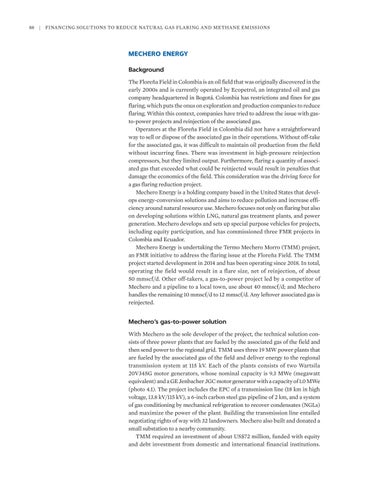88
| Financing Solutions to Reduce Natural Gas Flaring and Methane Emissions
MECHERO ENERGY Background The Floreña Field in Colombia is an oil field that was originally discovered in the early 2000s and is currently operated by Ecopetrol, an integrated oil and gas company headquartered in Bogotá. Colombia has restrictions and fines for gas flaring, which puts the onus on exploration and production companies to reduce flaring. Within this context, companies have tried to address the issue with gasto-power projects and reinjection of the associated gas. Operators at the Floreña Field in Colombia did not have a straightforward way to sell or dispose of the associated gas in their operations. Without off-take for the associated gas, it was difficult to maintain oil production from the field without incurring fines. There was investment in high-pressure reinjection compressors, but they limited output. Furthermore, flaring a quantity of associated gas that exceeded what could be reinjected would result in penalties that damage the economics of the field. This consideration was the driving force for a gas flaring reduction project. Mechero Energy is a holding company based in the United States that develops energy-conversion solutions and aims to reduce pollution and increase efficiency around natural resource use. Mechero focuses not only on flaring but also on developing solutions within LNG, natural gas treatment plants, and power generation. Mechero develops and sets up special purpose vehicles for projects, including equity participation, and has commissioned three FMR projects in Colombia and Ecuador. Mechero Energy is undertaking the Termo Mechero Morro (TMM) project, an FMR initiative to address the flaring issue at the Floreña Field. The TMM project started development in 2014 and has been operating since 2018. In total, operating the field would result in a flare size, net of reinjection, of about 50 mmscf/d. Other off-takers, a gas-to-power project led by a competitor of Mechero and a pipeline to a local town, use about 40 mmscf/d; and Mechero handles the remaining 10 mmscf/d to 12 mmscf/d. Any leftover associated gas is reinjected.
Mechero’s gas-to-power solution With Mechero as the sole developer of the project, the technical solution consists of three power plants that are fueled by the associated gas of the field and then send power to the regional grid. TMM uses three 19 MW power plants that are fueled by the associated gas of the field and deliver energy to the regional transmission system at 115 kV. Each of the plants consists of two Wartsila 20V34SG motor generators, whose nominal capacity is 9.3 MWe (megawatt equivalent) and a GE Jenbacher JGC motor generator with a capacity of 1.0 MWe (photo 4.1). The project includes the EPC of a transmission line (18 km in high voltage, 13.8 kV/115 kV), a 6-inch carbon steel gas pipeline of 2 km, and a system of gas conditioning by mechanical refrigeration to recover condensates (NGLs) and maximize the power of the plant. Building the transmission line entailed negotiating rights of way with 32 landowners. Mechero also built and donated a small substation to a nearby community. TMM required an investment of about US$72 million, funded with equity and debt investment from domestic and international financial institutions.


